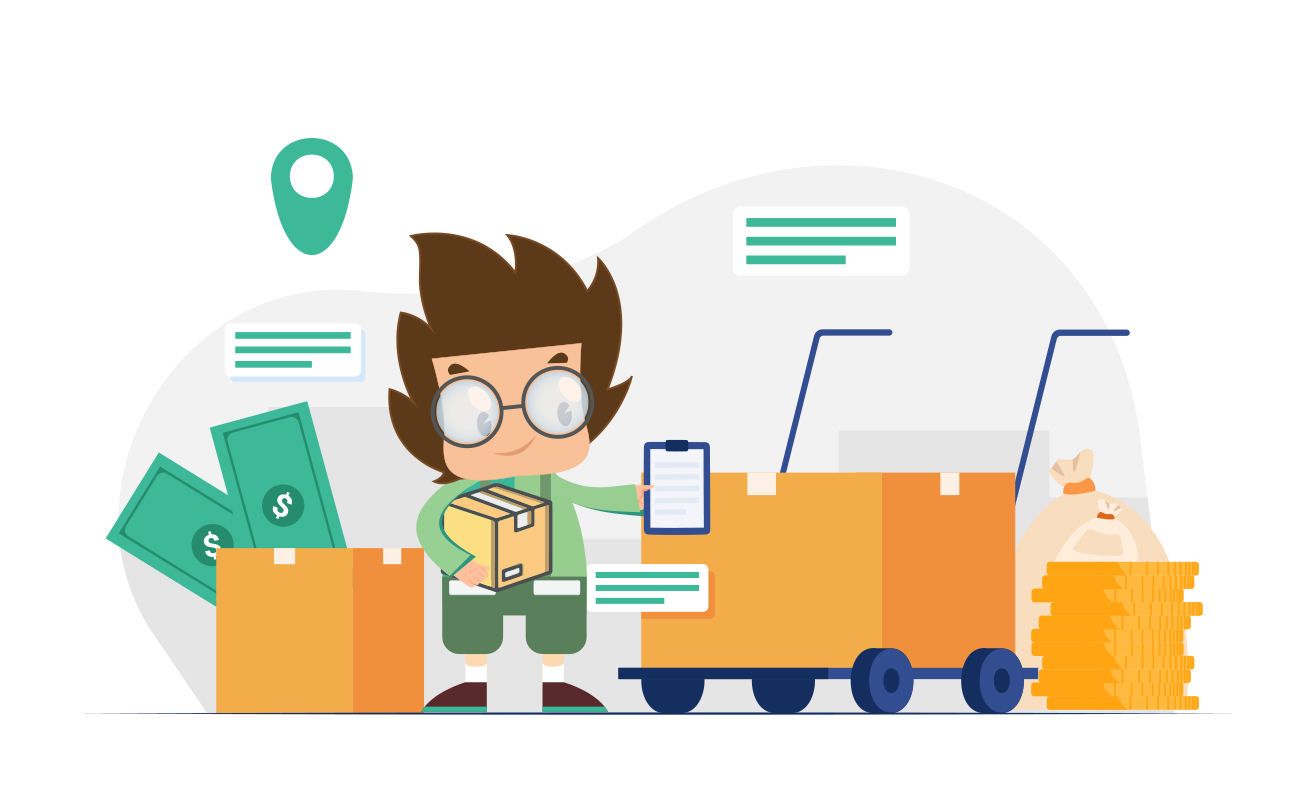Learn About Inventory Costs. Full Guide
Inventory Management
LAST UPDATE: JUL 6, 2022
5 minutes reading
Inventory Management is a vital aspect of a small business. and it consists of a big part of success if companies do it the right way.
businesses always look for methods to optimize inventory levels, increase profits, and keep costs at a low level.
What Are The Inventory Costs?
Inventory can be separated into many categories that you may have any or all. That means different types of costs in each category.
Inventory cost is often defined as the yearly percentage of the inventory value.
It is essential to assess the amount of profit and expenses related to inventory to find the right balance between costs against the final selling price to guarantee that you are on track to succeed in keeping your profit margins healthy.
Inventory-related costs are basically categorized into three main headings:
– Ordering costs -also called Setup costs.
– Carrying costs -also called Holding costs.
– Shortage costs -also called Stock-out costs.
Let’s define these notions below.
Ordering Costs
Ordering costs, also referred to as setup costs, are the costs incurred every time you place an order for procuring inventory from your supplier.
These costs include:
1- Clerical Costs Of Preparing Purchase Orders
It typically includes all kinds of clerical costs, such as fees for placing the order, invoice processing, accounting, and communication costs.
2- Transportation Costs
The costs of moving or transporting the goods from one place to another, for instance, warehouse or store.
3- Cost Of Finding Suppliers And Expediting Orders
These costs are essential expenses for the business and are likely inconsistent.
4- Receiving Costs
These costs include expenses that incur when receiving and unloading goods at the warehouse, also inspecting the merchandise to ensure they are the correct ones that were ordered and free of any defect.
5- Cost Of Electronic Data Interchange (EDI)
Large businesses, and especially retailers, use these systems to reduce the ordering process costs significantly.
No matter how big or small an order might be, there will be an ordering cost you have to incur, the more orders placed, the more the ordering costs increase.
The ordering costs can be minimized if you placed a bulk order over an extended period of time.
Ordering costs are related to the carrying cost of inventory and the replenishment cost as ordering costs vary depending on two factors the cost of ordering too much and the cost of ordering too less together are called Total Stocking Costs.
Ordering a high quantity of orders will result in more carrying cost of inventory while ordering less will increase replenishment cost and less of the carrying cost of inventory.
Total Stocking Cost is balanced when determining the Inventory Procurement decision by answering these two basic questions How much to order and When to order.
Businesses determine how much to order by using Economic Order Quantity or EOQ.
One of the ways used to minimize ordering costs is to develop long-term partnerships with reliable suppliers where that can provide volume discounts.
Ordering Cost Example
Let’s assume a company sells computers, here are examples of ordering costs the company may incur when making a purchase order of computer devices:
– Cost to prepare a purchase order.
– Cost of ordering tax.
– Cost of Insurance premiums paid on the product.
– Cost of inspection incurred as a result of order transportation.
– Cost of the labor required to handle and transport the order.
– Cost to process the supplier invoice related to an order and issue a payment to him.
– Cost of payment fee.
– Any other incurred costs = any tool taxes, maintenance costs, etc.
Now, how to determine the economic order quantity for its next product purchase.
If the company determines that the cost per order is $2,000, and the carrying cost per unit each year is $50. After evaluating sales projections, the company expects demand for the product to reach 20,000 units.
Using the formula of EOQ below:
EOQ = √[(2 x annual demand x cost per order) / (carrying cost per unit)]
EOQ = √[(2 x 20,000 x 2,000) / $50)]= √(1,600,000)
EOQ = 1,264.9=1265 units per order
Since the annual demand is 20,000 units, the company will have to place approx. 16 orders annually.
Total ordering cost will be $2000 * 16 = $32,000.
Carrying Costs
Carrying costs refers to the expenses of Inventory storage, management, and maintenance before it is sold. It is also known as holding costs because it is related to storing and maintaining inventory for a certain period of time.
The carrying costs of inventory typically include:
1- Inventory Financing Costs
These types include everything related to the investment made in inventory and include costs like interest on working capital.
2- The Opportunity Cost Of The Money Invested In Inventory
it could be found through the lost alternatives that have tied up money in inventory for instance investments in term deposits or mutual funds.
These two types of costs can be embedded in the so-called Cost of Capital which includes the costs related to the investment, interest on working capital, insurance costs, taxes on inventory paid, etc.
3- Storage Space Costs
These costs are typically related to the place where the companies store the inventory and it includes the cost of the building where it is owned or rented, as well as the costs of facility maintenance like lighting, air conditioning, heating, and ventilation, besides the property taxes and depreciation costs.
The inventory carrying cost is related to the decision of the management to manage inventory using in-house facilities or external warehouses through outsourced vendors and third-party service providers.
4- Inventory Services Costs
They are the costs that incur in the material handling equipment, IT hardware, and applications, it also includes expenses related to cycle counting and inventory control, insurance, and security, besides the cost of human resources employed in management and operations.
Inventory holding costs can be reduced when using the just-in-time inventory purchasing model (JIT) by ordering inventory exactly when it is needed. In this case, it will solve the problem of the saturation of the storage space and free up supply chain teams’ time to focus on their basic tasks.
5- Inventory Risk Costs
They cover essentially the risks that companies encounter in the loss of goods because of several reasons.
The major cost is the cost of shrinkage which is basically the loss of items between purchasing from the supplier and the final point of sale due to many reasons, for instance, vendor fraud, shipping error, pilferage and theft, damage in transit, or during the period of storage.
The other main example is deadstock caused by obsolescence. Obsolete items are products going past their use-by dates, or perishable goods, for instance, consumer electronics and fresh products that can lose their value like meat and cheese.
It is difficult to calculate the carrying costs because of the fact that they are very business-specific. But there are some quick methods of calculating the cost.
The first method puts the inventory carrying costs at 25% of the inventory value on hand.
Another approach to calculating the carrying cost of the inventory consists in adding 20% to the current prime rate for borrowing money. For example, if the prime rate is 15%, the carrying costs would be 15+20=35%.
Carrying Costs Example
As noted earlier, there is an inverse relationship between carrying and ordering costs. If the ordering costs rise, the carrying costs would drop, and vice versa.
The factor that determines the relation between the holding and ordering costs is EOQ (Economic Order Quantity).
This indicator has the level of inventory at which the sum of ordering and carrying costs is minimal.
The ordering costs and carrying costs will be at the minimum at the EOQ level, and if the company orders more or less than this level, then it will incur more inventory.
Let’s calculate the carrying costs in the previous example:
First, we need to calculate the average inventory.
Average Inventory= (Beginning Inventory + purchase) / 2.
The company has no beginning Inventory, so the average inventory would be 1265/2= 632.5 units. The total carrying costs is 632.5 * 50= $31,625
Total inventory cost for a company at EOQ level is the ordering cost plus carrying cost or $32,000 + $31,625 = $63,625.
Shortage Costs
It is also known as stock-out costs, these costs are incurred when businesses become out of stock for whatever reason. It can include disrupted production costs, emergency shipment costs, customer loyalty and reputation, and change of suppliers with faster deliveries.
Importance Of Knowing Inventory Costs
Understanding and tracking the different types of inventory costs can help you to manage the inventory better and offer control of your business income, expenses, and cash flow.
See also Inventory costing methods.
Conclusion
Measuring the inventory costs is not an easy task, as the inventory is a significant portion of the total assets of an organization, if the costs of inventory are high, it can have a big impact on the company’s cash flow.
As a result, finding the right balance will help you determine more finely the costs of the items, and ensure boosting your business for long-term success.



Recent Comments